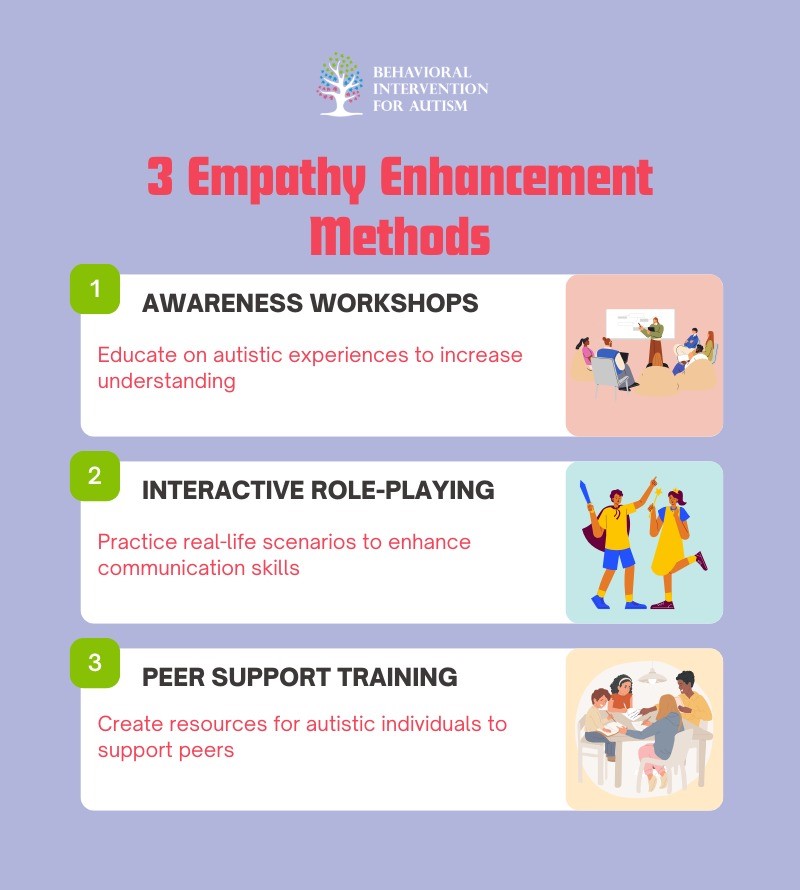
Table of Contents
Navigating social interactions can be challenging for both autism-spectrum and non-autistic individuals. The empathy divide between these groups is a significant factor in this struggle. Understanding this divide begins with exploring the theory of the double empathy problem and recognizing the differences in communication styles.
The Double Empathy Problem Theory
Dr. Damian Milton introduced the double empathy problem to clarify the disconnection between autistic and non-autistic people. This theory posits that autistic individuals do not lack empathy but experience and express emotions differently. These differences can lead to misunderstandings and difficulties in connecting with non-autistic individuals.
The double empathy problem can be further understood through the following points:
Key Aspect | Explanation |
Empathy Expression | Autistic individuals express emotions in unique ways, which may not align with non-autistic expectations. |
Misinterpretation | Non-autistic individuals may misinterpret autistic expressions as a lack of empathy. |
Reciprocal Understanding | Both groups may find it challenging to empathize with each other due to vastly different lived experiences. |
Differences in Communication Styles
Communication styles can greatly impact how individuals relate to one another. Autistic individuals often communicate in ways that differ significantly from non-autistic individuals, which can exacerbate the empathy divide. This can manifest through:
- Directness: Autistic communication tends to be more straightforward, whereas non-autistic individuals may rely on implied meanings and nuances.
- Response Expectations: Non-autistic responses may include normalizing autistic experiences, such as saying “we are all a bit on the spectrum.” This can be perceived as offensive by autistic individuals, as it undermines their authenticity and lived experience.
- Comfort Levels: Research indicates that autistic individuals find it easier to connect with other autistic individuals than with non-autistic individuals. Higher comfort levels and ease of communication often occur in interactions among peers with similar experiences.
Understanding the double empathy problem and differences in communication styles is essential for parents and caregivers. By fostering awareness and empathy, they can help bridge the gap between autistic and non-autistic individuals, promoting more meaningful connections.
Challenges of Empathizing
Empathy can be a complex area of interaction between autistic and non-autistic individuals. Several challenges arise due to misunderstandings and preconceived notions that affect mutual understanding.
Misunderstanding Autistic Expressions
Many non-autistic individuals often misinterpret the emotional expressions and gestures of autistic individuals. According to Dr. Damian Milton, the disconnection between autistic and non-autistic people primarily stems from variations in how emotions are experienced and expressed. Non-autistic individuals may view autistic expressions as lacking emotional depth, while in reality, they may simply differ in form.
The empathy divide does not manifest equally, as non-autistic methods of communication are frequently regarded as the standard, which can lead to the rejection of autistic ways as unorthodox or incorrect. This misunderstanding can create a significant barrier, making it difficult for non-autistic individuals to connect with their autistic counterparts.
Expression Type | Common Misinterpretation | Impact on Interaction |
Non-verbal cues | Lack of engagement | Assumption of disinterest |
Direct speech | Perceived bluntness | View as rude or unfeeling |
Emotional responses | Seen as exaggerated | Dismissal of genuine feelings |
Non-Autistic Misconceptions
Non-autistic individuals often hold misconceptions about empathy and communication in relation to autism, sometimes presuming their own ways of empathizing as superior. This belief results in an expectation that autistic individuals should adapt to non-autistic cultural norms without any reciprocal effort from non-autistic individuals to understand autistic perspectives.
Common misconceptions include the idea that autistic individuals lack empathy entirely. This notion undermines the authenticity and identity of autistic people. For instance, statements such as “we are all a bit on the spectrum” can be taken as trivializing the lived autistic experience.
Misconception | Reality |
Autistic individuals lack empathy | Autistic individuals express and experience emotions differently |
Non-autistic communication is superior | Both autistic and non-autistic individuals communicate effectively in different contexts |
Autistic behavior is unintelligible | Autistic behaviors can have clear meanings when understood from an autistic perspective |
Understanding these challenges is essential for parents and caregivers. By acknowledging the differences in expression and communication styles, they can foster more empathetic and supportive environments for both autistic individuals and their non-autistic counterparts.
Impact on Social Interactions
The social dynamics between autistic and non-autistic individuals are often complex and can lead to significant challenges. It explores two key aspects of these interactions: challenges in forming connections and the stigma surrounding autism.
Difficulty in Making Connections
Autistic individuals frequently encounter obstacles when trying to interact with their non-autistic peers. Research indicates that non-autistic individuals tend to form negative first impressions of autistic people within seconds. This quick judgment can diminish their interest in establishing connections, leading to fewer opportunities for friendships and social engagement.
Factors Affecting Connections | Impact on Autistic Individuals |
Negative first impressions | Less interest in social interactions |
Misunderstandings of communication styles | Reduced opportunities to build friendships |
Lack of awareness of autistic experiences | Perceived as socially awkward or unapproachable |
Autistic individuals often find more comfort in connecting with their fellow autistic peers. The shared understanding between autistic individuals fosters greater ease of communication and connection.
Stigma and Social Marginalization
The stigma surrounding autism can lead to social marginalization, further complicating the lives of autistic individuals. The double empathy problem illustrates how the lack of understanding between autistic and non-autistic individuals can result in negative social consequences. Autistic individuals may encounter challenges accessing education, employment, and necessary services.
Areas Affected by Stigma | Consequences for Autistic Individuals |
Employment | Enhanced barriers to job opportunities |
Education | Limited access to resources and support |
Mental health | Increased vulnerability due to social isolation |
Criminal justice interactions | Risk of misunderstanding and mistreatment |
Autistic individuals frequently express feelings of being undervalued or dismissed in social contexts. This experience not only impacts their mental health but also creates a cycle of marginalization that can be difficult to break. The combination of difficulty in making connections and the stigma surrounding autism reinforces social barriers, making it imperative to address these issues within communities.
Promoting Mutual Understanding
To address the challenges posed by the double empathy problem, promoting mutual understanding is essential. This involves improving communication channels and enhancing empathy and acceptance between autistic and non-autistic individuals.
Improving Communication Channels
Effective communication is foundational in bridging the gap between autistic and non-autistic individuals. Autistic individuals often find it easier to connect and share experiences with other autistic individuals. This underscores the importance of creating supportive environments where these interactions can flourish.
Communication Aspect | Autistic Individuals | Non-Autistic Individuals |
Comfort Level in Interaction | Higher with autistic peers | Varies, often lower with autistic individuals |
Accuracy in Information Sharing | Similar to non-autistic groups | Consistent with accuracy levels |
Autistic individuals can effectively share information, especially with peers who share the same experiences. Establishing connections through support groups and community forums can enhance these interactions. It is important to create settings where concerns and ideas can be expressed freely.
Enhancing Empathy and Acceptance
Encouraging empathy and acceptance is crucial in tackling misunderstandings. Non-autistic individuals may sometimes respond in ways that minimize the autistic experience, such as equating it with being “a bit on the spectrum.” These responses can be perceived as offensive and indicate a lack of authentic understanding of autistic identity.
Building empathy requires education and awareness of the unique experiences faced by autistic individuals. Engaging in workshops and interactive sessions can help foster greater awareness of how to communicate effectively and respectfully with autistic individuals.

Promoting mutual understanding between autistic and non-autistic individuals is vital for forming meaningful connections. This journey of enhancing communication and acceptance can lead to improved social interactions, deeper connections, and a more inclusive environment for everyone involved.
Take the Next Step Toward Better Understanding
If you’re ready to deepen connections and support meaningful communication, we’re here to help. At Behavioral Intervention for Autism, we provide personalized ABA therapy services designed to bridge gaps in understanding, focusing on the unique needs of each individual. Our team is dedicated to creating positive outcomes through evidence-based strategies that truly make a difference. Explore how our ABA programs in Florida can support your loved one’s journey. Don’t wait—reach out today, connect with us, and let’s make progress together.
Sources:
- 9 Common Obsessions of Children With Autism You Should Know - February 25, 2025
- What is Neurodiversity? A Guide to Embracing Differences - February 25, 2025
- Understanding Hyperfocus in Autism: What It Means and Why It Happens - February 25, 2025


